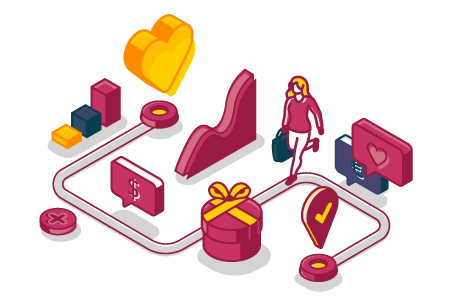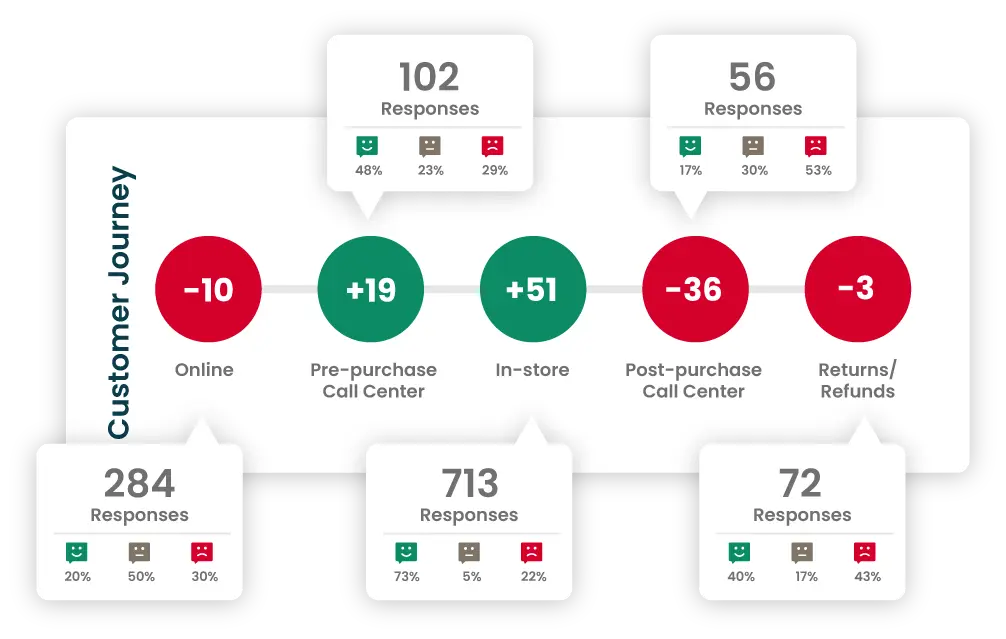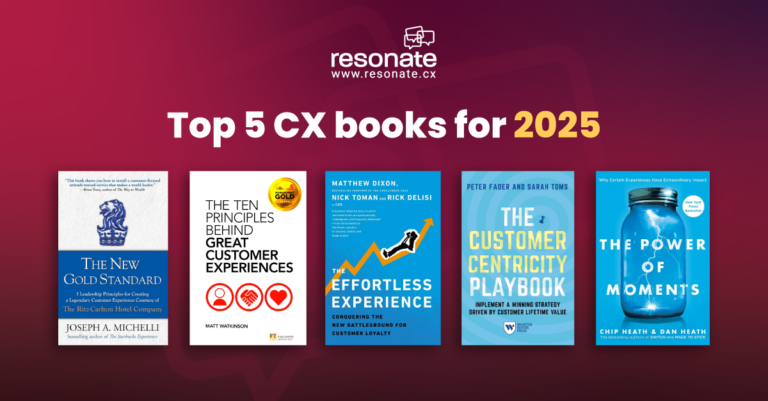What Is the Customer Journey?
Every customer experience with your brand is uniquely their own. The customer journey framework is the entire experience a person has when interacting with a business, from the very first time they hear about it to when they become a loyal customer (or even stop using the product or service).

Though it can be presented in any number of ways, the customer journey is typically divided into distinct stages so that businesses are better able to identify the common needs, pain points, and expectations of customers at each part of the process. A deeper, organisation-wide understanding of the customer journey will enable businesses to systematically create relevant experiences while also steering them clear of actions that may alienate customers.
Customer Journey Mapping and Why It Matters
As the old saying goes: when your only tool is a hammer, every problem looks like a nail. In any organisation, the way through which different departments understand customer issues is usually the lens of their responsibilities.
When a company starts to scale up, the idea of what customers need and experience can become quite different from the perspectives of marketing, sales, product development, customer service, and other stakeholders. While different departments might disagree on what customers want, the customers themselves will still be doing whatever it is they’re doing, regardless of what anyone thinks. A data-supported map illustrating how customers interact with a business can bring clarity to the situation, uniting stakeholders and avoiding wasted effort.
We’ve previously touched on customer journey mapping, but it’s worth reiterating why the practice has so much value. The concept is very similar to the conventional “sales funnel” framework and it’s often combined with it for illustrative purposes. However, customer journeys are more realistic, non-linear, and comprehensive, fully accounting for the richness and complexity of today’s multichannel customer interactions.
Customer journey maps provide a unified idea of how customers interact with a business, laying the groundwork for a coherent experience across all customer touchpoints. With a customer journey map, businesses can more easily:
Identify Pain Points
Customer journey maps allow for a deeper understanding of how customers perceive as they interact with a business, making it possible to pinpoint areas where customers encounter difficulties.
Improve Customer Experiences
Knowing what irks and delights customers allows companies to make more meaningful improvements that build a positive overall customer experience.
Boost Customer Retention
Because customer journey maps enable better basic experiences for customers, they facilitate higher levels of repeat business. Also, because the maps account for post-purchase relationships, businesses that use these frameworks are better placed to retain customers and turn them into advocates, raising their brand profile and lowering the baseline costs associated with each conversion.
Smarter Data-Driven Decisions
Customer journey maps provide context for customer feedback data, empowering businesses to make better sense of what their data is telling them.
Total Organisational Alignment
A well-mapped, data-supported customer journey ensures that all departments can move as one to deliver the same goal: better customer experience.
Stages of the Customer Journey
A basic customer journey map typically consists of five main stages: awareness, consideration, decision, retention, and advocacy.
Unlike the traditional funnel model where customers simply move down or drop out, customer journey maps recognise the diversity of customer experiences, with customers moving freely among the stages, responding to new information or forgetting what they’ve learned. These stages should form the initial basis for your customer journey map, which you can later modify to more closely fit your needs:
1. Awareness
This is when customers first come into contact with your brand through channels like advertising, social media, or word-of-mouth conversations. The goals here are to grab the customer’s attention and make them recognise a potential issue that you can help with.
2. Consideration/Interest
During this phase, your customers will be actively researching potential solutions to their problems, both from your selection of offerings as well as from your competitors. Customers with a strong interest but some hesitance may look for reviews, testimonials, or case studies. Your business can offer relevant information to build trust and bolster the logical and emotional arguments in favour of buying.
3. Decision
Customers at this stage are ready to convert. This is a critical moment since any friction can lead to a delay or a complete reconsideration of the purchase. Factors like pricing, product availability, and the level of customer service right at the point of sale each play a significant role in reinforcing the decision to buy.
4. Retention
This is where customer journey maps deviate significantly from the classic funnel model. Once the customer has made a purchase, the focus shifts to nurturing the relationship that you had just developed with them. Providing adequate after-sales support, loyalty programmes, and regular communication can all play roles in keeping customers interested in your business after they have purchased.
5. Advocacy
At this stage, customers have gone beyond simply being retained and have begun promoting your brand out of their own accord. They may leave positive reviews, recommend your business to others, or share their positive experiences on social media. Advocacy is the ultimate goal, as it not only drives new sales from the same customers but also boosts new customer acquisition through word-of-mouth, potentially leading to more conversions and more committed long-term customers.
Key Touchpoints in the Customer Journey
Touchpoints are the various moments of interaction between customers and your business. Some of these touchpoints are especially critical because of the way they can drive conversions and advocacy. Important touchpoints include but are certainly not limited to:
- Website Visits
- Social Media Interactions
- Online Advertising
- Traditional Advertising
- Email Marketing
- Direct Mailers
- In-Store Experiences
- E-Commerce Purchases
- Customer Service Channel Interactions
Surveys are a practical way to gather feedback at these touchpoints. With Resonate CX’s customer experience management (CXM) solutions, your business can interpret these survey results and gain nuanced customer insights in real time. Resonate CX can convert unstructured survey feedback into usable data with powerful AI-driven features like text analytics. For in-store customers who choose not to answer surveys, Resonate’s facial emotion analytics can also provide an accurate analyses of their sentiments, giving you your most refined understanding of your customers to date.

Resonate CXM platform supports:
- Inner Loop: Address individual feedback quickly, like resolving issues after a negative purchase experience.
- Outer Loop: Analyse patterns in feedback to make broader improvements, such as refining products or processes.
Best Practices for Optimising the Customer Journey
Mapping the customer journey is just the start. To make it impactful, you need to refine and use it effectively. Here’s how:
1. Know Your Customers
Ground customer journey maps in data, not assumptions.
To keep things simple, use Resonate’s powerful AI capabilities to accurately sort your customers according to general behaviours, needs, and pain points. You can also ensure that everyone in your organisation understands your customers with Customer Centre Stage, a tool designed to provide businesses with a unified understanding of customer journeys and experiences.
2. Leverage Data Analytics to Uncover Hidden Issues and Wider Themes
Identify hidden issues and patterns with reliable data. Resonate CX’s analytics tools make it easy to uncover common threads and hidden issues across customer surveys, allowing you to build a consistently accurate picture of customers’ wants and needs.
3. Create Relevant Customer Experiences
Use CX insights to design experiences aligned with customer expectations, reducing friction and increasing loyalty.
4. Provide Seamless Navigation That Is Conducive to Conversion
Simpler buying experiences lead to more conversions. Simplify buying experiences across digital and in-store channels. Make websites, apps, and physical layouts intuitive and easy to navigate. For in-store experiences, provide clear signage, easy-to-navigate layouts, and well-trained staff who can guide customers through the store all contribute to a seamless in-store journey.
5. Encourage Customer Feedback
Actively seek feedback from customers to understand their experience. With Resonate’s AI-native Voice of the Customer program, you can quickly sift through mountains of survey data to immediately find pain points and opportunities to further delight customers.
6. Respond to Customers Quickly
You need to be ready to receive feedback at all times. Make sure customers can contact your business across social media, phone, email, and live chat at all times. Furthermore, you should automate survey distribution during critical touchpoints, like after a purchase, a customer service interaction, or a store visit. When customers provide feedback over these channels, make it a priority to close the feedback loop as soon as possible so that customers feel heard and valued.
7. Optimise Apps and Websites for Mobile Users
Globally, brand discoveries and conversions are now largely facilitated through mobile devices, which means the ‘desktop-first’ approach to online customer experience design may no longer apply to your business. As a rule, it’s a good idea to ensure that your website and app are optimised for mobile users.
8. Regularly Update Your Customer Journey Maps
Customers and the market environments they inhabit are always evolving, and as such, your business’s customer journey maps must evolve with them. Use the survey data extracted by our CXM solutions to continually fine-tune your maps so that you never miss an opportunity to improve the customer experience.
The Next Step: Integrating Customer Journey Insights into Your Business
Mapping the customer journey is just the beginning. Analysing the data and letting the customer journey map guide your business decisions are also essential to becoming truly responsive to your customers’ needs. Once your entire business has a realistic understanding of core customer experiences, it can finally act to sustainably drive conversions and cultivate customer advocacy, securing its place in today’s hypercompetitive markets.
Investing in Resonate CX’s AI-powered customer experience management solutions will ensure that your path to better customer understanding is supported by data at every step. Request a demo today and start developing data-backed customer journey maps with full confidence.







